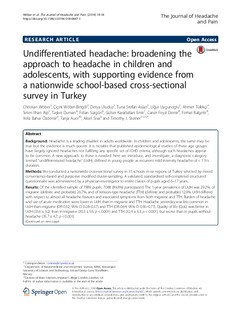| dc.contributor.author | Wöber, Christian | |
| dc.contributor.author | Wöber-Bingöl, Çiçek | |
| dc.contributor.author | Uluduz, Derya | |
| dc.contributor.author | Aslan, Tuna Stefan | |
| dc.contributor.author | Uygunoglu, Uğur | |
| dc.contributor.author | Tüfekçi, Ahmet | |
| dc.contributor.author | Alp, Selen Ilhan | |
| dc.contributor.author | Duman, Taşkın | |
| dc.contributor.author | Sürgün, Fidan | |
| dc.contributor.author | Emir, Gülser Karadaban | |
| dc.contributor.author | Demir, Caner Feyzi | |
| dc.contributor.author | Balgetir, Ferhat | |
| dc.contributor.author | Özdemir, Yeliz Bahar | |
| dc.contributor.author | Auer, Tanja | |
| dc.contributor.author | Siva, Aksel | |
| dc.contributor.author | Steiner, Timothy J. | |
| dc.date.accessioned | 2019-02-25T13:58:18Z | |
| dc.date.available | 2019-02-25T13:58:18Z | |
| dc.date.created | 2019-01-12T22:27:17Z | |
| dc.date.issued | 2018 | |
| dc.identifier.citation | The Journal of Headache and Pain. 2018, 19:18 1-9. | nb_NO |
| dc.identifier.issn | 1129-2369 | |
| dc.identifier.uri | http://hdl.handle.net/11250/2587282 | |
| dc.description.abstract | Background
Headache is a leading disabler in adults worldwide. In children and adolescents, the same may be true but the evidence is much poorer. It is notable that published epidemiological studies of these age groups have largely ignored headaches not fulfilling any specific set of ICHD criteria, although such headaches appear to be common. A new approach to these is needed: here we introduce, and investigate, a diagnostic category termed “undifferentiated headache” (UdH), defined in young people as recurrent mild-intensity headache of < 1 h’s duration.
Methods
We conducted a nationwide cross-sectional survey in 31 schools in six regions of Turkey selected by mixed convenience-based and purposive modified cluster-sampling. A validated, standardised self-completed structured questionnaire was administered by a physician-investigator to entire classes of pupils aged 6–17 years.
Results
Of the identified sample of 7889 pupils, 7088 (89.8%) participated. The 1-year prevalence of UdH was 29.2%, of migraine (definite and probable) 26.7%, and of tension-type headache (TTH) (definite and probable) 12.9%. UdH differed with respect to almost all headache features and associated symptoms from both migraine and TTH. Burden of headache and use of acute medication were lower in UdH than in migraine and TTH. Headache yesterday was less common in UdH than migraine (OR 0.32; 95% CI 0.28–0.37) and TTH (OR 0.64; 95% CI 0.56–0.77). Quality of life (QoL) was better in UdH (33.6 ± 5.2) than in migraine (30.3 ± 5.6; p < 0.001) and TTH (32.4 ± 5.3; p < 0.001), but worse than in pupils without headache (35.7 ± 4.7; p < 0.001).
Conclusions
This large nationwide study in Turkey of pupils aged 6–17 years has shown that many children and adolescents have a headache type that does not conform to existing accepted diagnostic criteria. This new diagnostic category of presumably still-evolving headache (undifferentiated headache) is common. UdH differs in almost all measurable respects from both migraine and TTH. Although characterised by mild headaches lasting < 1 h, UdH is associated with significant adverse impact on QoL. Longitudinal cohort studies are needed to evaluate the prognosis of UdH but, meanwhile, recognition of UdH and its distinction from migraine and TTH has implications for epidemiological studies, public-health policy and routine clinical practice. | nb_NO |
| dc.language.iso | eng | nb_NO |
| dc.publisher | Springer Open | nb_NO |
| dc.rights | Navngivelse 4.0 Internasjonal | * |
| dc.rights.uri | http://creativecommons.org/licenses/by/4.0/deed.no | * |
| dc.title | Undifferentiated headache: broadening the approach to headache in children and adolescents, with supporting evidence from a nationwide school-based cross-sectional survey in Turkey | nb_NO |
| dc.type | Journal article | nb_NO |
| dc.type | Peer reviewed | nb_NO |
| dc.description.version | publishedVersion | nb_NO |
| dc.source.pagenumber | 1-9 | nb_NO |
| dc.source.volume | 19:18 | nb_NO |
| dc.source.journal | The Journal of Headache and Pain | nb_NO |
| dc.identifier.doi | 10.1186/s10194-018-0847-1 | |
| dc.identifier.cristin | 1655537 | |
| dc.description.localcode | © The Author(s). 2018 This article is distributed under the terms of the Creative Commons Attribution 4.0 International License (http://creativecommons.org/licenses/by/4.0/), which permits unrestricted use, distribution, and reproduction in any medium, provided you give appropriate credit to the original author(s) and the source, provide a link to the Creative Commons license, and indicate if changes were made. | nb_NO |
| cristin.unitcode | 194,65,30,0 | |
| cristin.unitname | Institutt for nevromedisin og bevegelsesvitenskap | |
| cristin.ispublished | true | |
| cristin.fulltext | original | |
| cristin.qualitycode | 1 | |

